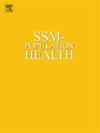Reconceptualizing rurality: Exploring community capital to identify distinct rural classes in the United States
IF 3.6
2区 医学
Q1 PUBLIC, ENVIRONMENTAL & OCCUPATIONAL HEALTH
引用次数: 0
Abstract
Background
In population health research, rurality is often defined using broad population density measures, which fail to capture the diverse and complex characteristics of rural areas. While researchers have developed more nuanced approaches to study neighborhood and area effects on health in urban settings, similar methods are rarely applied to rural environments. To address this gap, we aimed to explore dimensions of contextual heterogeneity across rural settings in the US.
Methods
We conducted an exploratory latent class analysis (LCA) to identify distinct classes of rurality. Using the Community Capitals Framework, we collated and analyzed nationally representative data for each domain of rural community capital across all rural census tracts in the US (n = 15,643). Data for this study were sourced from ten publicly available datasets spanning the years 2018–2021. To provide preliminary validation of our findings, we examined the Social Vulnerability Index (SVI) percentile rankings across the identified rural classes.
Results
A four-class model solution provided the best fit for our data. Our LCA results identified four distinct classes of rurality that vary in terms of capital types: Outlying (n = 3,566, 22.7%), Developed (n = 3,210, 20.5%), Well-Resourced (n = 4,896, 31.3%), and Adaptable (n = 3,981, 25.4%). The mean SVI percentile rankings differed significantly across these classes, with Well-Resourced having the lowest and Adaptable the highest mean percentile rankings.
Conclusions
We identified different types of rurality at the census tract level that fall along a social gradient as indicated by variation in SVI percentile rankings. These findings highlight that each rural class has a unique combination of community capitals. This nuanced approach to conceptualizing rurality provides the opportunity to identify interventions that meet specific rural communities' unique strengths and needs.
重新定义乡村:探索社区资本以识别美国不同的农村阶层。
背景:在人口健康研究中,农村性通常使用广泛的人口密度指标来定义,这未能捕捉到农村地区的多样性和复杂性特征。虽然研究人员已经开发出更细致入微的方法来研究城市环境中社区和地区对健康的影响,但类似的方法很少应用于农村环境。为了解决这一差距,我们旨在探索美国农村环境的背景异质性维度。方法:我们进行了探索性潜类分析(LCA),以确定不同的乡村性类别。使用社区资本框架,我们整理和分析了美国所有农村人口普查区农村社区资本每个领域的全国代表性数据(n = 15,643)。这项研究的数据来自2018年至2021年期间的十个公开数据集。为了初步验证我们的发现,我们检查了社会脆弱性指数(SVI)在确定的农村阶层中的百分位数排名。结果:四类模型解最适合我们的数据。我们的LCA结果确定了资本类型不同的四种不同类型的乡村:偏远(n = 3,566, 22.7%)、发达(n = 3,210, 20.5%)、资源充足(n = 4,896, 31.3%)和适应性强(n = 3,981, 25.4%)。这些类别的平均SVI百分位数排名差异很大,资源充足的排名最低,适应性强的排名最高。结论:我们在人口普查区水平上确定了不同类型的乡村性,这些乡村性沿着社会梯度下降,如SVI百分位数排名的变化所示。这些发现突出表明,每个农村阶层都有独特的社区资本组合。这种将农村概念化的细致入微的方法为确定满足特定农村社区独特优势和需求的干预措施提供了机会。
本文章由计算机程序翻译,如有差异,请以英文原文为准。
求助全文
约1分钟内获得全文
求助全文
来源期刊

Ssm-Population Health
PUBLIC, ENVIRONMENTAL & OCCUPATIONAL HEALTH-
CiteScore
6.50
自引率
2.10%
发文量
298
审稿时长
101 days
期刊介绍:
SSM - Population Health. The new online only, open access, peer reviewed journal in all areas relating Social Science research to population health. SSM - Population Health shares the same Editors-in Chief and general approach to manuscripts as its sister journal, Social Science & Medicine. The journal takes a broad approach to the field especially welcoming interdisciplinary papers from across the Social Sciences and allied areas. SSM - Population Health offers an alternative outlet for work which might not be considered, or is classed as ''out of scope'' elsewhere, and prioritizes fast peer review and publication to the benefit of authors and readers. The journal welcomes all types of paper from traditional primary research articles, replication studies, short communications, methodological studies, instrument validation, opinion pieces, literature reviews, etc. SSM - Population Health also offers the opportunity to publish special issues or sections to reflect current interest and research in topical or developing areas. The journal fully supports authors wanting to present their research in an innovative fashion though the use of multimedia formats.
 求助内容:
求助内容: 应助结果提醒方式:
应助结果提醒方式:


